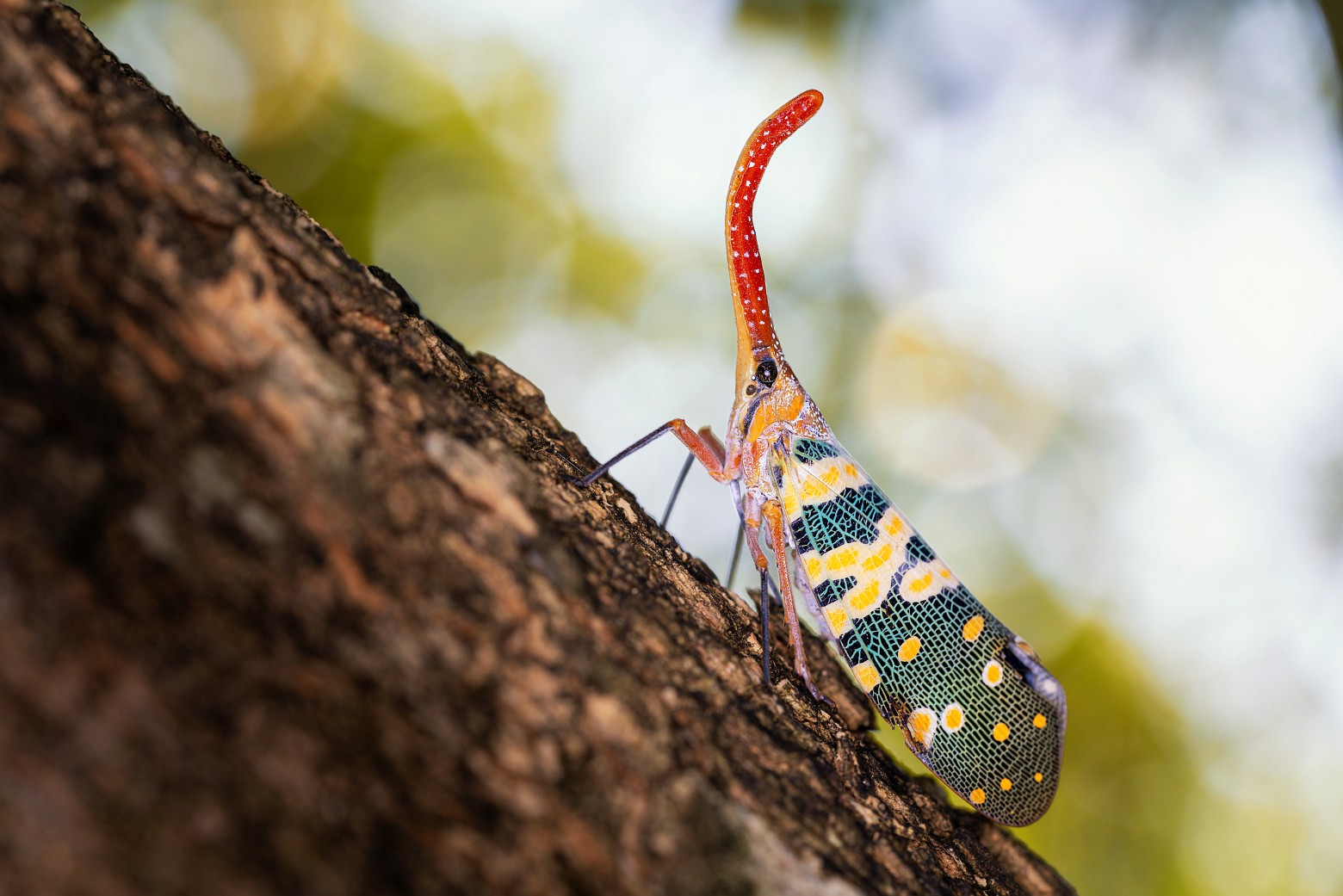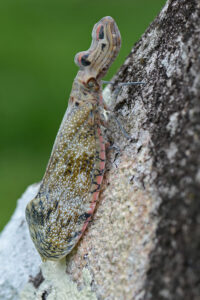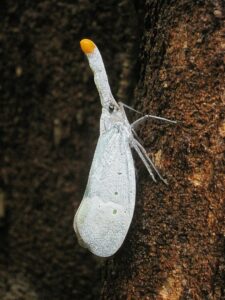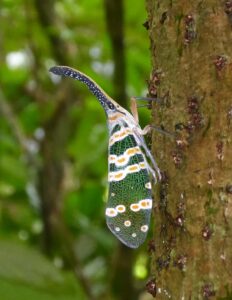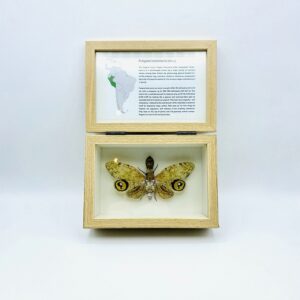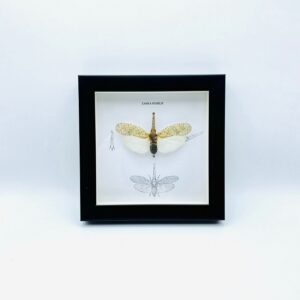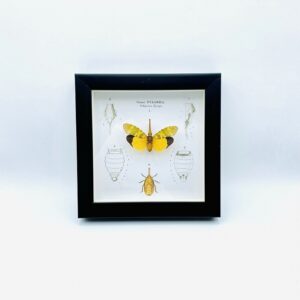What is a Lantern Bug?
Lantern bugs are members of the order Hemiptera, the order of insects containing what are commonly called “true bugs”. Most hemipterans feed on plants, as is the case with lantern bugs. The incredible structure that many lantern bugs exhibit on the top of their head, as seen in the image above, includes a small mouthpiece used to puncture and feed on plant cells. After puncturing the thick cell walls of the plants, they use the mouthpiece to suck out the sap found in the cells.
Sap from plant cells includes a high level of glucose, other sugars, and all of the proteins and fats that the small insects need to survive. Though all lantern bug species eat in this manner, there is incredible variety within the family Fulgoridae, found mostly in the genus Fulgora and the genus Pyrops.
Examples of Lantern Bugs
Lantern bugs have an incredible number of types and are spread across many genera of the family Fulgoridae. Many of the lantern bug species found in the “Old World” (Europe and Asia) are found within the family Pyrops. An example of this genus is seen in the image below. Notice the distinct and notable “lantern” which extends from the head of the insect.
This white lantern bug was found in Russia, though the species occupies much of Europe and Asia. Another common genus, found mostly in the “New World” of the Americas, is the genus Fulgora. Represented both in the first image and the one below, this lantern bug is is commonly called the “peanut-head” bug. While this is an accurate description, this lantern bug is likely employing a form of mimicry, and the bug does not intend to look like a peanut. Notice that with its wings open, it looks a lot like bird poop. This is likely an evolutionary adaptation which disguises the lantern bug from potential predators.
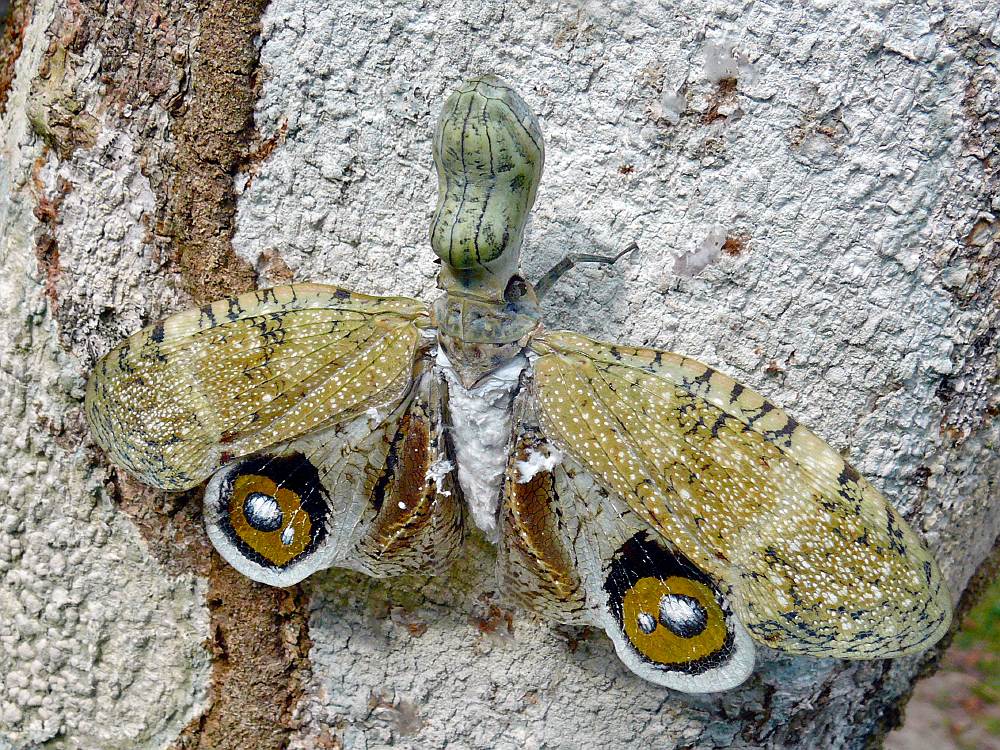
The above lantern bug is found in Guatemala, where it has been naturally present for thousands of years. Because of the amount of time it has spent in this environment, the bug has adapted to the ecosystem, and the ecosystem has adapted to the bug. For this reason, the insect has a hard time flourishing, as it is in a constant arms race with the local flora and its natural predators.
However, without natural predators or plants which have adaptive defenses, a population of lantern bugs can quickly become a nuisance. Consider, for instance, the spotted lanternfly, a member of the genus Lycorma. This Old World species was recently found in Pennsylvania and Virginia. Without any natural predators or plants with appropriate defenses, these insects have the potential to do massive damage to local crops. The lantern bug will feed, thrive, and have population explosions on crops like grapes, hardwood and timber, and stone fruits such as peaches. Below is an image of the lantern bug Lycorma delicatula, an organism currently considered an invasive species in the United States.
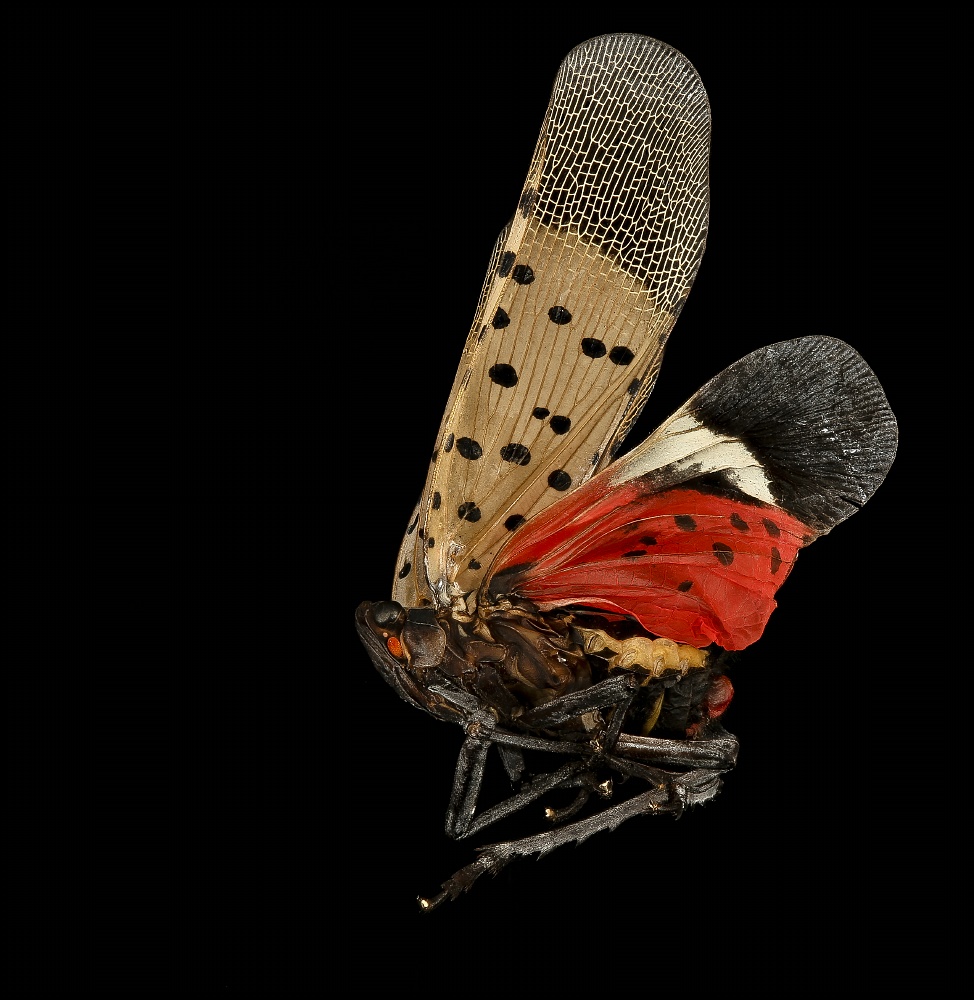
Do Lantern Bugs Make Light?
Lantern bugs have many names. In some places they are called lantern flies, in others, they are called lantern moths, and in still other parts of the world they are called “lanthorn flies”. Yet, all of these names refer to lanterns because it was once believed that the lantern-shaped head portion of the bugs produced light at night.
However, this was just a myth that was propagated by scientist first tasked with identifying and naming the small bugs. Around 1675, this task fell to Maria Sibylla Merian, one of the first and most well-written entomologists to ever collect and classify the lantern bug. Merian, though accurate in most of her account, also included a description of the lantern bug’s strangely shaped head, and postulated that it might be able to produce light in the darkness.
Carl Linnaeus, the father of modern taxonomy and the system of binomial nomenclature, picked up on this myth and published it as well. When building his massive record of life, the Systema Naturae, Linnaeus also wrote that lantern bugs had the capability to produce light. He based his information on Merian’s account, which was published almost 60 years prior, and never bothered to test whether a lantern bug can produce light. Thus, the myth was propagated for many, many years until modern entomologists finally set the record straight.
So, no. Lantern bugs do not produce light. However, their strange and ornamental headpieces do resemble lanterns from those days. These lanterns were sometimes made out the horn of a bull or other animal, leaving behind the monicker “lanthorn”, which is a sort of Old English colloquial word for the description of a lantern made of horn.
The Lifecycle Of Lantern Bugs
Lantern bugs start life inside of an egg, which their mother has laid on a tree, rock, building, or any other solid and protected surface. After laying a line of eggs, she covers the egg cluster in a thick coating of a waxy substance. The substance acts as insulation, and as a protective barrier against physical harm.
Here, the small larva of the lantern bug will develop over the winter. In the late spring, the nymph lantern bug will emerge from the egg, ready to find and devour some plants. At this stage, the lantern bug has no wings and relies on its ability to hop from leaf to leaf to find food. Here, you can see a picture of a lantern bug in the first instar, or first stage of its life.
Over the course of the coming months, the lantern bug will go through 3 more stages. Near the middle of summer, the lantern bug will enter the final, adult stage of life by molting. During this process, the lantern bug will grip a tree, rock, or other suitable location while it develops wings and adult features. It will break out of its old exoskeleton, unfurl its new wings, and after they have fully hardened the lantern bug is ready to fly.
Typically, the lantern bug only flies when it needs to travel long distances. For instance, when food has run out or there are no suitable mates in the area, the lantern bug will take up a wing to the next tree or shrub, and look for resources there. Once on a tree, the lantern bugs prefer to hop and crawl their way along the branches to the leaves or areas of the trunk they can penetrate.
Together, this mass of insects can actually do considerable damage to a tree or a entire crop. While they feed, they also excrete the part of the plant sap which they cannot digest. They let this excrement fall to the ground, which often accumulates at the base of a tree or plant infested by lantern bugs. If there is enough excrement, a common fungus will take hold on the ground, creating a ring of black mold around the base of the tree. Known as “sooty mold”, this fungus is often a tell-tale sign that the lantern bug is infesting and destroying a tree.
After the individuals molt and become adults, they seek out other individuals to mate with and the cycle starts all over. Adults typically do not last through the winter. As such, every spring brings a new generation of lantern bugs ready to mow down the season’s greenery.
The Many Different Types of Lantern Bug
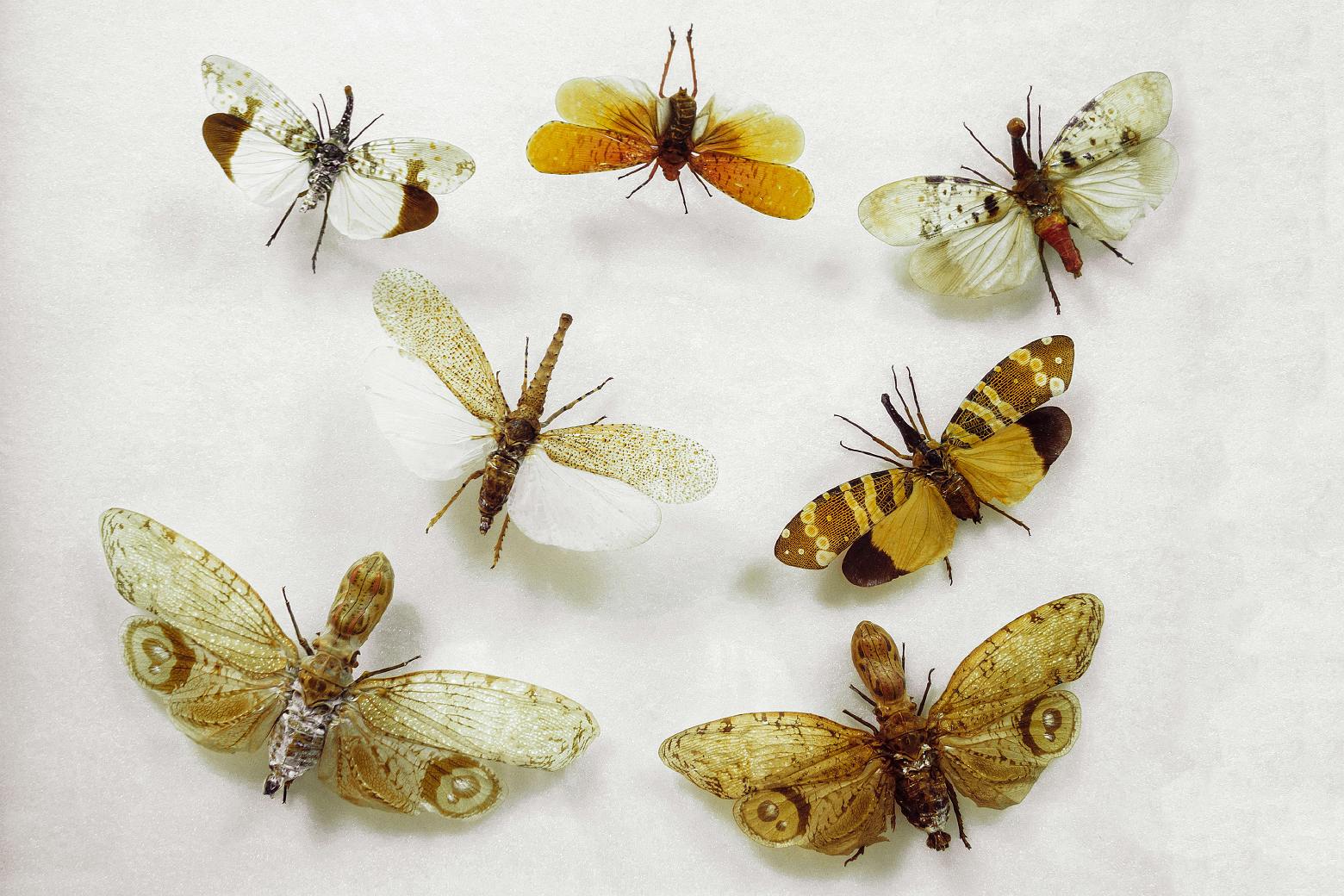
Besides the several species of lantern bug already mentioned, there are many more. In fact, there are over 125 genera of the family Fulgoridae. These members are found worldwide, though some of the individual genera are found only in certain parts of the world. Seen below is a very camouflaged specimen, found in India.
Still, other varieties of lantern bug have much more fascinating coloration, such as this red and blue lantern bug. Surprisingly, this species is also found in India but exists slightly different. Instead of hiding from predators, it warns predators that it may be toxic with its intense coloration, especially the red tones. This lantern bug also shows that some within the group do not have large lanterns, but rather a small extension on the head.
Other lantern bugs have even crazier coloration, such as this specimen below from France. The markings on this lantern bug are likely also to scare away predators. But, they may also be characteristics derived through sexual selection, a powerful process of natural selection which can create fantastic and otherwise useless adaptations.
Truly, lantern bugs are a fascinating group with an incredible life cycle, multitudes of form, and a worldwide distribution. Many people collect these insects for their beauty and strange forms, many of which are not shown here.
Check out the products in our webshop related to lantern bugs:

